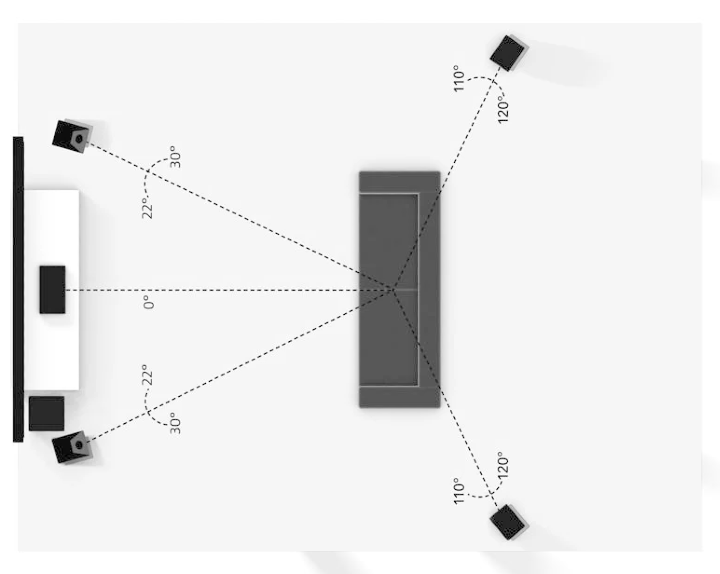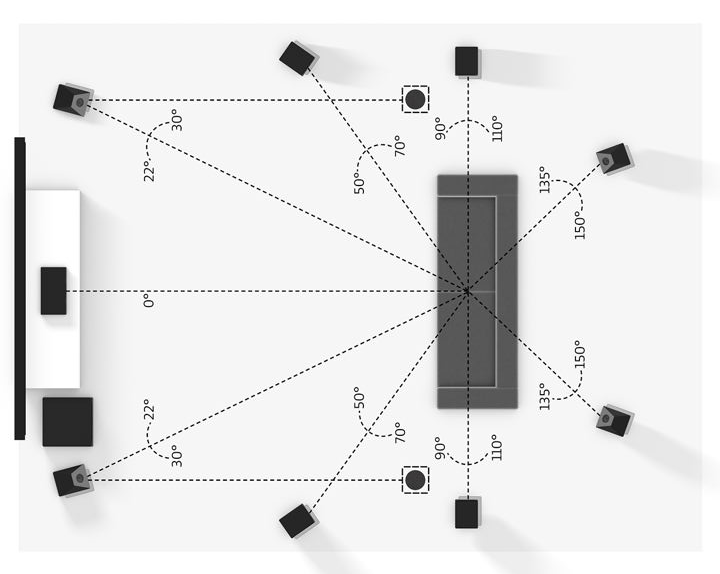Resources

Speaker Configuration
Projection & UHD TV Screens
When mounting your projector, consider the throw distance and screen size. Ensure adequate distance from the screen to avoid any distortion.
Choosing the right screen to match your projector is crucial. Select a screen material that matches your room’s lighting conditions—either reflective for brighter rooms or a darker, matte finish for controlled lighting environments.
Audio
Dolby Atmos technology adds overhead sound, creating a more three-dimensional audio experience. Look for systems that support Atmos for a breathtaking soundstage. 5.1.4 and 7.1.4 setups: These configurations offer an excellent balance of traditional surround sound and overhead audio. Choose a receiver from brands like Yamaha or Marantz that supports these setups for optimal performance. Systems that are THX certified ensure that the audio quality meets strict standards. Consider using THX-certified speakers to enhance your movie nights.
Let’s start on your Home Theater
How many speakers will I need?

Dolby 5.1.2

Dolby 9.1.6
Group 1
Group 2
My System













-

Title
Lorem ipsum dolor sit amet, consectetur adipiscing elit, sed do eiusmod tempor incididunt ut labore et dolore magna aliqua. Ut enim ad minim veniam, quis nostrud exercitation ullamco laboris nisi ut aliquip ex ea commodo consequat. -

Title
Lorem ipsum dolor sit amet, consectetur adipiscing elit, sed do eiusmod tempor incididunt ut labore et dolore magna aliqua. Ut enim ad minim veniam, quis nostrud exercitation ullamco laboris nisi ut aliquip ex ea commodo consequat. -

Title
Lorem ipsum dolor sit amet, consectetur adipiscing elit, sed do eiusmod tempor incididunt ut labore et dolore magna aliqua. Ut enim ad minim veniam, quis nostrud exercitation ullamco laboris nisi ut aliquip ex ea commodo consequat. -

Title
Lorem ipsum dolor sit amet, consectetur adipiscing elit, sed do eiusmod tempor incididunt ut labore et dolore magna aliqua. Ut enim ad minim veniam, quis nostrud exercitation ullamco laboris nisi ut aliquip ex ea commodo consequat. -

Title
Lorem ipsum dolor sit amet, consectetur adipiscing elit, sed do eiusmod tempor incididunt ut labore et dolore magna aliqua. Ut enim ad minim veniam, quis nostrud exercitation ullamco laboris nisi ut aliquip ex ea commodo consequat.
Video Resources
The best aspect ratio for a home theater depends on the type of content you plan to watch:
-
16:9 A versatile choice for general viewing, as it’s the standard for HDTV signals, Blu-ray discs, and most television broadcasts. It’s also the aspect ratio for most home theater projectors and flat panel TVs. However, you might see black bars on widescreen movies
-
2.35:1 Also known as CinemaScope, this aspect ratio mimics the view of a movie theater and is best for dedicated movie enthusiasts.

| Ratio | Description | Tip |
| 1:1 | This aspect ratio provides a perfectly squared screen format for overhead projectors (OHP) and is commonly used in Educational/Classroom environments. | Choose this format if you are using a native SVGA/XGA Projector and occasionally use an OHP or 1:1 slide projector for your presentations |
| 4:3 | This aspect ratio is the same as a standard television (Non-High Definition) or computer (SVGA, XGA, UXGA) resolution | Select this format screen if you are using a native SVGA, XGA or UXGA projector for your presentations |
| 16:10 | This is the most popular aspect ratio for the latest WXGA or WUXGA notebooks. | Choose the 16:10 screen if you use a native wide screen notebook or wide XGA (UXGA) projector. |
| 16:9 | This is the High Definition Television (HDTV) format and is the most widely used aspect ratio for the latest television designs. | Choose a 16:9 Projection Screen if you are planning to use it with a native 16:9 format projector. |
| 2.35:1 | Widescreen Cinemascope format which is perfect with the new anamorphic lenses on the market today. | Select this 2.35:1 format screen if your application is strictly home theater Cinemascope presentations. 2.35:1 and 16:9 are the most popular format for Home Cinema. |
Stellar Specials and Latest News
We'll let you know when new promotions and exciting, out-of-this-world news come within range




